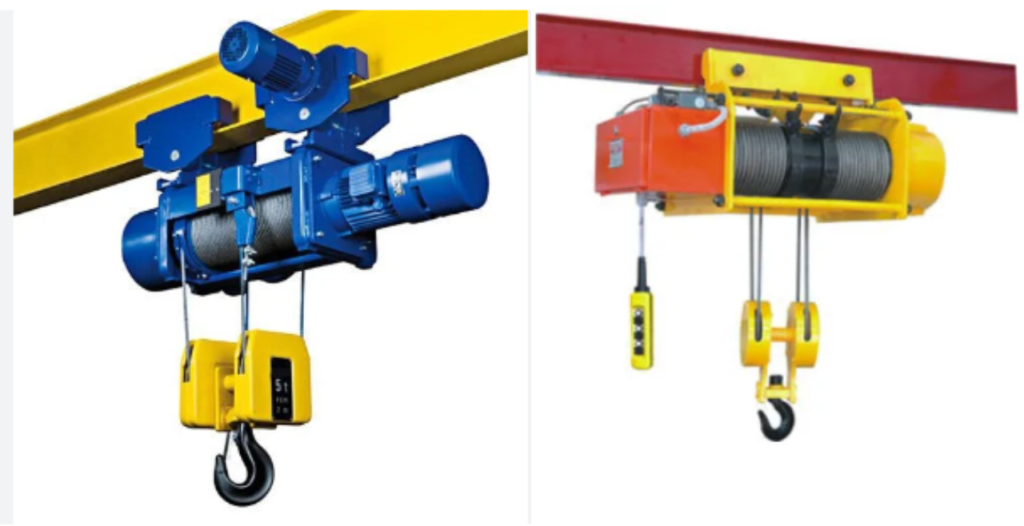CRANES & COMPONENTS TECHNOLOGY & PRODUCTS
Hoists / Electric Hoists
| Hoists are mechanical devices used for lifting and lowering heavy loads in various industries and applications. They come in various forms, from simple manual hoists to more complex powered hoists. In this detailed overview, we will discuss the key aspects of hoists, including their working principles, advantages, disadvantages, applications, materials of construction (MOC), and provide a summary. |
| 1. Working Principles: Hoists operate on basic mechanical principles to lift and lower loads. The key working principles include: |
| Drum or Winch: Most hoists have a drum or winch with a cable or chain wound around it. When the drum rotates in one direction, the cable is wound onto the drum, lifting the load. When the drum rotates in the opposite direction, the cable is unwound, lowering the load. |
| Power Source: Hoists can be manually operated, using a hand-operated crank or lever for smaller loads, or they can be powered by electricity, pneumatics, or hydraulics for heavier loads. Electric hoists are the most common type. |
| Control Mechanism: Hoists are equipped with controls to start, stop, and control the speed and direction of lifting and lowering operations. Controls can be on the hoist itself or operated remotely. |
| Hook or Attachment: A hook, attachment point, or lifting device is used to secure the load to the hoist’s cable or chain. |


| 2. Advantages: | |||||||
| Lifting Capacity: Hoists are designed to handle heavy loads, making them suitable for a wide range of applications. | |||||||
| Precision: Hoists provide precise control over the lifting and lowering process, allowing for accurate positioning of loads. | |||||||
| Safety: Modern hoists come with safety features such as limit switches, overload protection, and emergency stop buttons. | |||||||
| Efficiency: They improve efficiency in material handling and reduce manual labor. | |||||||
Versatility: Hoists can be used in various industries and applications, from construction and manufacturing to warehousing and maintenance.
|

| 4. Applications: Hoists find applications across various industries for material handling, including: |
| Construction: Lifting and positioning heavy materials and equipment on construction sites. |
| Manufacturing: Moving materials, components, and products within manufacturing facilities. |
| Warehousing: Stacking and retrieving heavy goods in warehouses and distribution centers. |
| Mining: Lifting and transporting materials and equipment in mining operations. |
| Automotive: Lifting vehicle parts and components during assembly. |
| Maintenance and Repair: Hoisting machinery and equipment for maintenance purposes. |
| Shipping and Ports: Loading and unloading cargo from ships and containers. |
| 5. Materials of Construction (MOC): The materials of construction for hoists depend on factors such as load capacity, environmental conditions, and industry-specific requirements. Common materials include: |
| Steel: Steel is often used for the main structural components of hoists, providing strength and durability. |
| Aluminum: Used in some applications where weight reduction is critical. |
| Special Coatings: Some parts may have specialized coatings to enhance corrosion resistance. |
| 6. Summary: Hoists are versatile mechanical devices used for lifting and lowering heavy loads in various industries. They operate on basic mechanical principles and provide advantages such as high lifting capacity, precision, safety features, efficiency, and versatility. However, they come with costs, maintenance requirements, space considerations, the need for skilled operators, and potential downtime during repairs. Hoists find applications in construction, manufacturing, warehousing, mining, automotive, maintenance and repair, and shipping, with materials of construction chosen based on specific requirements and environmental conditions. |


 Sales & Marketing:
Sales & Marketing:  Service Supports:
Service Supports:  Website:
Website: 